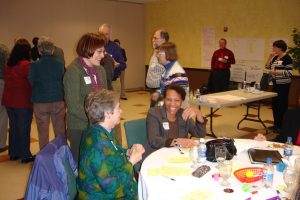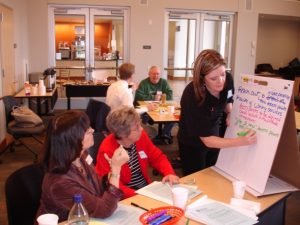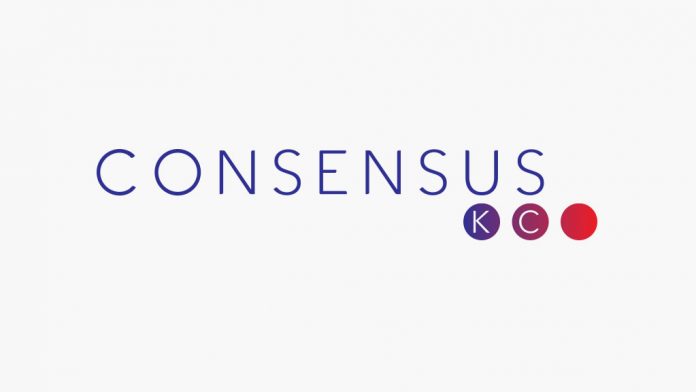How to tame the logistics involved in your small-group discussion
In 2013, Consensus is helping replace the old public hearing model, which citizens don’t like, with small groups, which work so much better. Every newsletter will include an article about small groups and how to use them. The February article covered the benefits of small groups https://www.consensuskc.org/2013/04/small-groups-work-better-and-consensus-helps-you-use-them/. Future articles will cover the questions to ask and how to document small groups, among other topics. In addition, Consensus will provide two hours of free consulting to cities, school boards and other entities to help them use small groups effectively. To take us up on the offer, contact Jennifer Wilding at [email protected].
When people talk about public hearings, they often invoke that moment in the Wizard of Oz where Dorothy and her friends cower in front of the huge, pulsating head of The Great and Powerful Oz hovering above them. Room set-up affects participants on a conscious and subconscious level. The typical public hearing space, with officials on a stage and people in rows facing them, is intimidating and reduces participation. Small-group discussions may use the same materials – gotta have chairs – but the effect is more welcoming.
Let’s say that a typical public hearing in Happytowne draws 60 members of the public, plus assorted city council members and staff. Hearings are held in the council chamber, which was designed for that purpose. The space probably stays in public hearing configuration most of the time. If Happytowne replaces a public hearing with a small-group model, it will require doing a few things differently. Soon, though, the new model will feel comfortable and familiar.
A typical small-group engagement begins with everyone in one large room to get instructions. Then, depending on the size of the room and its acoustics, people may stay in the big room or move to smaller rooms. After that, everyone convenes again so that the small groups can report on their discussions.
When you think about where to hold the small-group discussion, keep these things in mind:
• Small groups can’t be conducted using auditorium-style seating. If the chairs are fixed to the floor, use a different room.
• You can’t fit as many people into a room when they’re working in small groups as you can when they’re seated auditorium-style.
• The acoustics are important. At a hearing, one person (typically) talks at once, but if you have six small groups, you have six people talking.
If Happytowne’s council chamber has decent acoustics and the chairs are movable, it will serve just fine as the large room, and they can reserve other rooms for any overflow. If the chairs are fixed or the acoustics don’t work, the council can book space elsewhere, usually at a nearby school or library.
So now it’s time to arrange the room in Happytowne’s new configuration. It’s pretty simple. If you have round tables for six or eight, move them into the space and add chairs. Keep as much room as you can between the tables, so folks can move around. If you don’t have tables, don’t worry about it; just arrange chairs in a circle. Put a sturdy flip chart easel and table at the front of the room for the lead facilitator, and clear off as much wall space as you can for hanging flip chart pages. No need to move pictures if you’re okay with people taping paper to glass. Blue painter’s tape is safe for almost any surface.
Next, make sure you have the right supplies on hand. You may not need all of these for one meeting, if have them on hand and you’ll be ready for anything. Most can be used at several meetings.
• Flip chart easels. The facilitator and each table will need one. Get one sturdy easel for the facilitator. For each table, you have choices: 1) an inexpensive aluminum easel that stands on the floor; 2) a cardboard table-top flip chart that stands on the table; or 3) a stack of flip chart pages taped to the wall by each table (but be sure not to write on the last page, so you don’t leave marks).
• Flip chart pads. Post-it pads are nice, but not necessary.
• Markers. At least two for each table. Get the kind that don’t bleed, and toss the yellow ones. Test before each meeting to be sure they still work.
• Masking tape, or blue painter’s tape if you have fragile surfaces. If you have fabric walls, consider using pins.
• Sticky dots for dot voting. Toss the yellow ones.
Those are the basics. It may not be the most exciting part of planning for a small-group discussion, but skillful room set-up makes a big difference in the quality of the discussion and the comfort of the participants.



